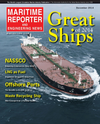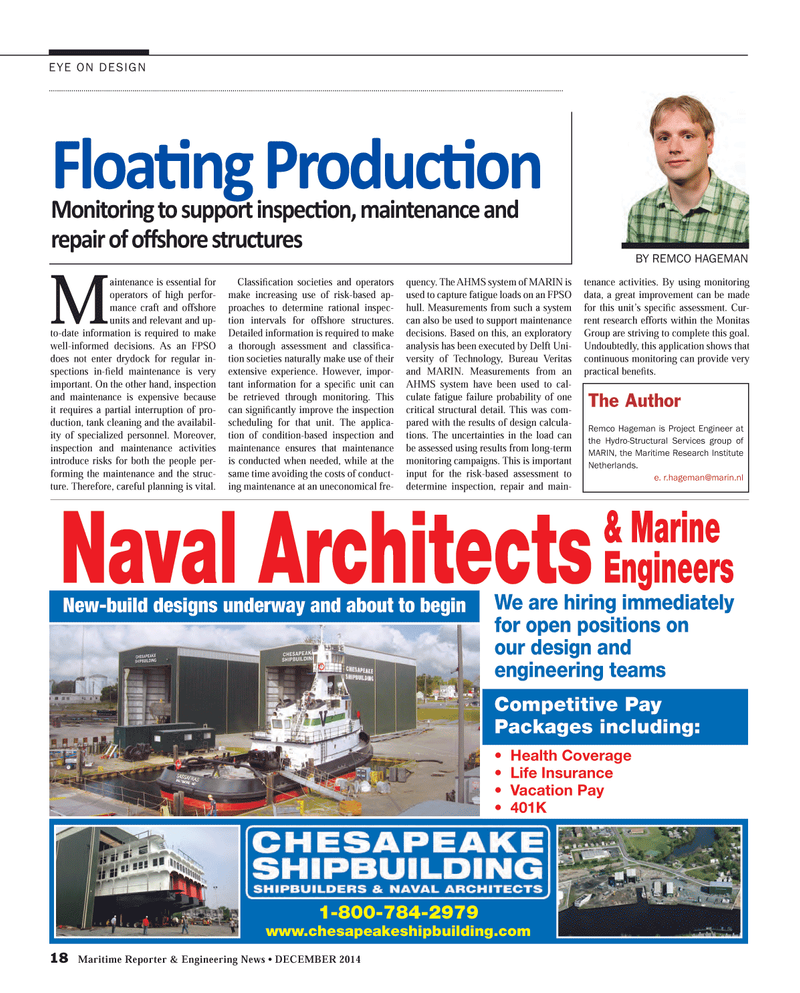
Page 18: of Maritime Reporter Magazine (December 2014)
Great Ships of 2014
Read this page in Pdf, Flash or Html5 edition of December 2014 Maritime Reporter Magazine
18 Maritime Reporter & Engineering News • DECEMBER 2014
M aintenance is essential for operators of high perfor- mance craft and offshore units and relevant and up- to-date information is required to make well-informed decisions. As an FPSO does not enter drydock for regular in- spections in-fi eld maintenance is very important. On the other hand, inspection and maintenance is expensive because it requires a partial interruption of pro- duction, tank cleaning and the availabil- ity of specialized personnel. Moreover, inspection and maintenance activities introduce risks for both the people per- forming the maintenance and the struc- ture. Therefore, careful planning is vital.
Classifi cation societies and operators make increasing use of risk-based ap- proaches to determine rational inspec- tion intervals for offshore structures.
Detailed information is required to make a thorough assessment and classifi ca- tion societies naturally make use of their extensive experience. However, impor- tant information for a specifi c unit can be retrieved through monitoring. This can signifi cantly improve the inspection scheduling for that unit. The applica- tion of condition-based inspection and maintenance ensures that maintenance is conducted when needed, while at the same time avoiding the costs of conduct- ing maintenance at an uneconomical fre- quency. The AHMS system of MARIN is used to capture fatigue loads on an FPSO hull. Measurements from such a system can also be used to support maintenance decisions. Based on this, an exploratory analysis has been executed by Delft Uni- versity of Technology, Bureau Veritas and MARIN. Measurements from an
AHMS system have been used to cal- culate fatigue failure probability of one critical structural detail. This was com- pared with the results of design calcula- tions. The uncertainties in the load can be assessed using results from long-term monitoring campaigns. This is important input for the risk-based assessment to determine inspection, repair and main- tenance activities. By using monitoring data, a great improvement can be made for this unit’s specifi c assessment. Cur- rent research efforts within the Monitas
Group are striving to complete this goal.
Undoubtedly, this application shows that continuous monitoring can provide very practical benefi ts.
EYE ON DESIGN
Floati ng Producti on
Monitoring to support inspecti on, maintenance and repair of o? shore structures
BY REMCO HAGEMAN
The Author
Remco Hageman is Project Engineer at the Hydro-Structural Services group of
MARIN, the Maritime Research Institute
Netherlands. e. [email protected]
We are hiring immediately for open positions on our design and engineering teams
New-build designs underway and about to begin
Competitive Pay
Packages including: • Health Coverage • Life Insurance • Vacation Pay • 401K
Naval Architects & Marine
Engineers 1-800-784-2979 www.chesapeakeshipbuilding.com
NEW 18.indd 18 12/2/2014 4:43:43 PM

 17
17

 19
19
